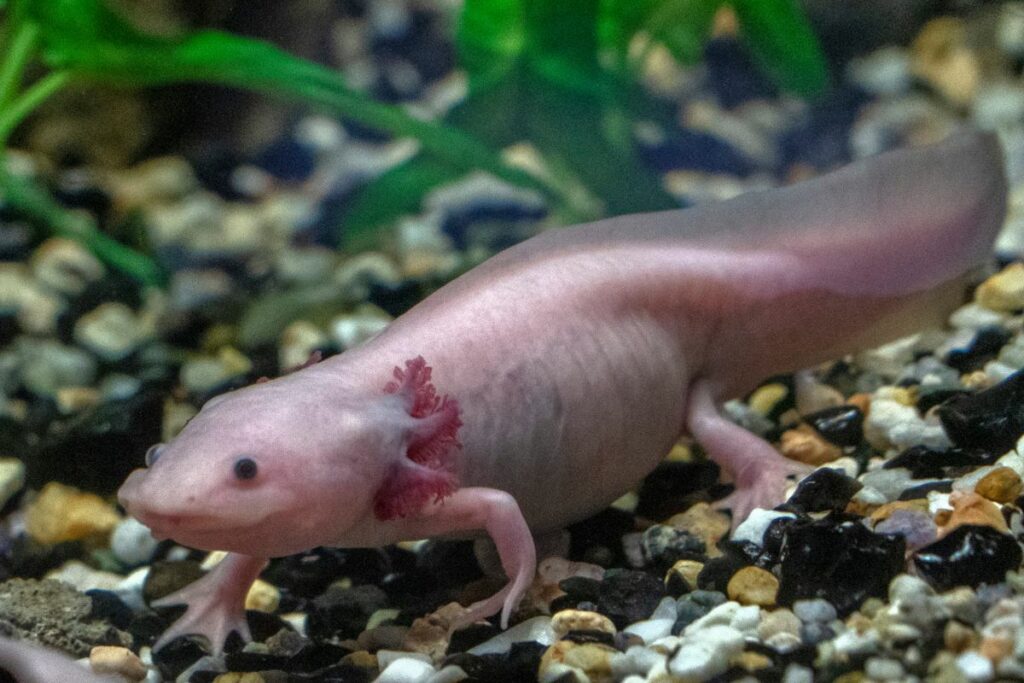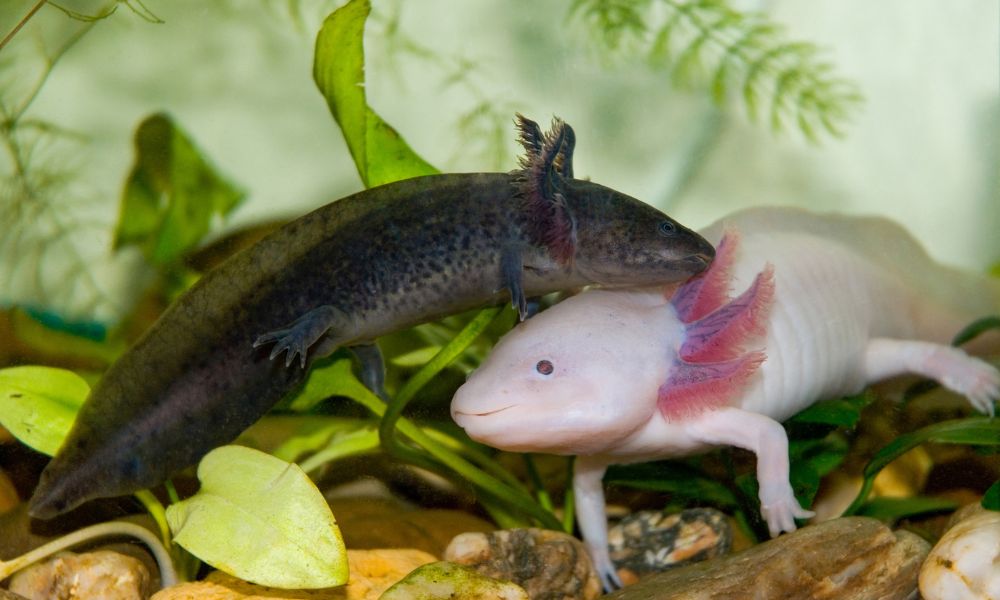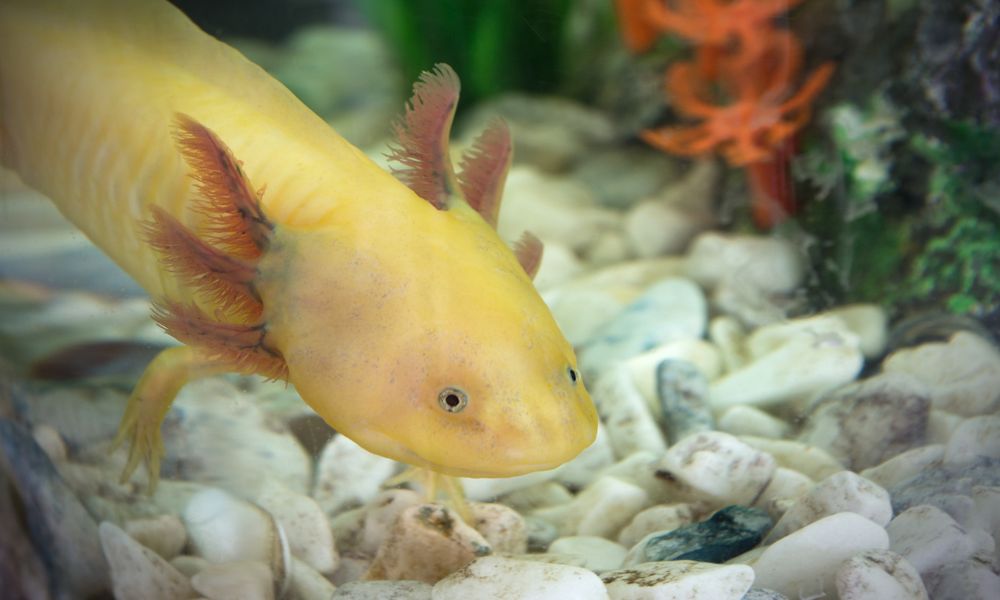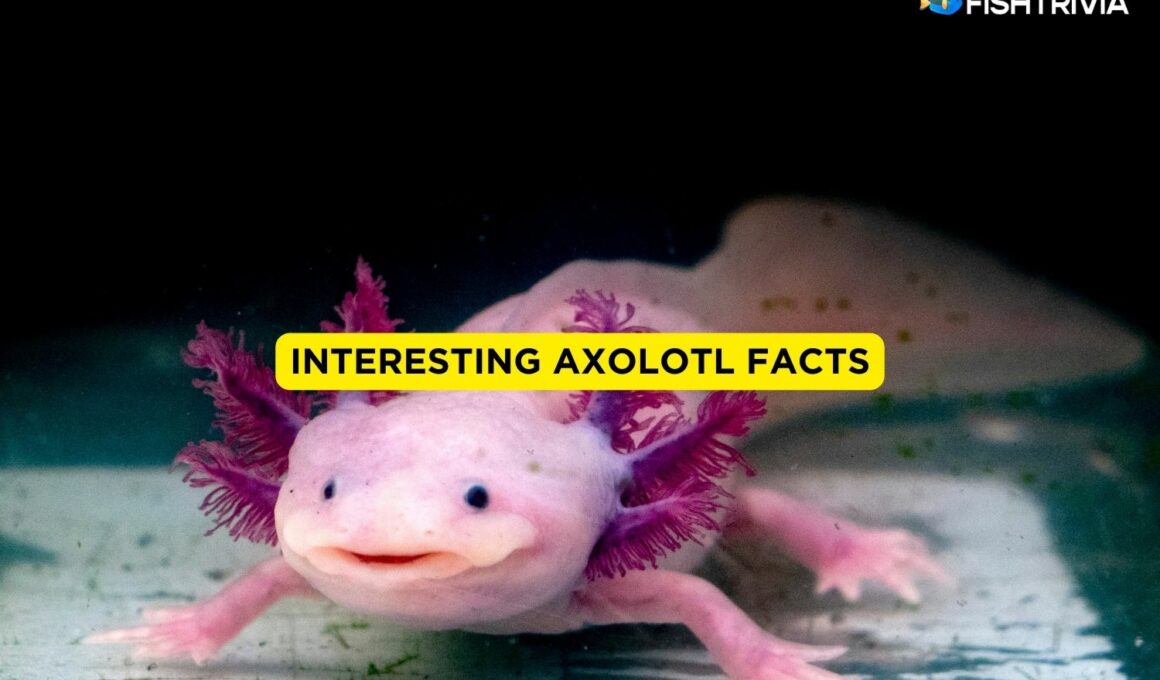In this article Show
As an experienced aquarium hobbyist, I’ve developed a deep appreciation for these remarkable creatures, and I’m excited to share insights that blend professional knowledge with the practicalities of home aquarium care.
Axolotls, often recognized for their distinctive appearance and playful demeanor, are not just another aquatic pet. They stand out for their extraordinary biological features and behaviors.
In this post, we’ll uncover nine captivating facts about axolotls, each shedding light on why these animals are much more than just aquarium inhabitants. Our journey through the world of axolotls promises to be enlightening, offering a blend of scientific intrigue and practical tips for those considering these creatures as pets.

Fact 1: Unique Regeneration Abilities of Axolotls
One of the most remarkable abilities of axolotls, setting them apart in the animal kingdom, is their astounding capacity for regeneration. Unlike many other species, axolotls can regenerate entire lost body parts, a feat that has long fascinated scientists and aquarium enthusiasts alike.
When an axolotl loses a body part, such as a limb, tail, or even portions of its heart and other internal organs, it can regrow these structures completely.
This regeneration process is not just about re-growing tissue; it involves the intricate reformation of bones, muscles, nerves, and blood vessels, all returning to full functionality. This ability extends even to their spinal cord, making them unique among vertebrates.
What’s particularly intriguing is the precision of this regeneration. The new limb, for instance, is not a mere approximate replacement. It’s a perfect mirror of the lost limb, both in form and function.
This process occurs through a complex interplay of cellular and molecular mechanisms, where cells at the injury site revert to a more primitive state (similar to stem cells) and then differentiate to rebuild the missing structures.
For those keeping axolotls as pets, this regenerative ability also highlights the resilience of these creatures. However, it’s essential to maintain optimal tank conditions and handle them with care to prevent injuries and ensure their well-being.
Fact 2: Perpetual Larval State of Axolotls
A defining and unusual characteristic of axolotls is their state of neoteny, meaning they retain juvenile features throughout their entire life. This biological phenomenon sets axolotls apart from most other amphibian species.
In simple terms, axolotls spend their entire lives in what can be described as a larval stage, a phase other amphibians only experience temporarily. In most amphibian species, the lifecycle involves a metamorphosis from a water-dwelling larva to a land-based adult. However, axolotls skip this transformation.
They reach sexual maturity without undergoing the typical metamorphosis that other amphibians, like frogs and salamanders, experience. As a result, adult axolotls retain gills and continue to live underwater just like their larval predecessors.
The gills, feathery appendages located on the sides of their heads, are a visually striking feature of axolotls. These external gills, along with a lateral line system similar to that found in fish, are adaptations for their fully aquatic lifestyle. Despite having rudimentary lungs, axolotls primarily breathe through their gills and skin.
This perpetual larval state is not just a fascinating quirk of nature; it has profound implications. It allows axolotls to reproduce while still in what is essentially a juvenile form, a rare trait in the animal kingdom. Additionally, this neoteny is closely linked to their remarkable regenerative abilities, as their juvenile state includes cellular properties conducive to regeneration.
Fact 3: Native Habitat and Conservation Status of Axolotls
The native habitat of axolotls is as unique as the creatures themselves. Axolotls originate from a very specific region in Mexico, specifically the lake complex of Xochimilco near Mexico City. These freshwater amphibians thrive in the lake’s system of canals and marshy areas, which provide the perfect environment for their aquatic lifestyle.
The unique water conditions of Xochimilco, with its cool temperature and rich biodiversity, have shaped the axolotl’s distinctive biology and behavior. However, the axolotl’s natural habitat has been under significant threat in recent decades. Urbanization, pollution, and invasive species have drastically reduced their native population.
These environmental pressures have led to a severe decline in their numbers in the wild, rendering the axolotl critically endangered. The wild population of axolotls is a stark contrast to their relatively common presence in aquariums around the world.
The conservation status of axolotls is a matter of significant concern. Being listed as critically endangered by the International Union for Conservation of Nature (IUCN), axolotls face a high risk of extinction in the wild.
Conservation efforts are underway to protect and restore their natural habitat, and breeding programs aim to sustain their population. These efforts are crucial, not just for the preservation of the species, but also for maintaining the ecological balance of their native environment.

Fact 4: Variety of Colors in Axolotls
Axolotls exhibit a fascinating array of color variations, which differ significantly between their wild and captive populations. In the wild, axolotls typically display a dark, mottled coloration, primarily a blend of greens, browns, and blacks. This natural pigmentation provides excellent camouflage in their murky lake habitats, aiding in their survival.
In contrast, captive axolotls, bred selectively over generations, showcase a much broader spectrum of colors. These variations are not just visually striking but also interesting from a genetic standpoint. Some of the most common color variants in captivity include:
- Leucistic: Often mistaken for albino, leucistic axolotls have a white or pink body with black eyes. They lack most pigmentation, giving them a ghostly appearance.
- Albino: True albinos are completely devoid of pigment, resulting in a light pink or golden color with red eyes.
- Melanoid: This variant has an increased amount of melanin, resulting in a uniformly dark, almost black appearance, without any mottling or gold speckling.
- Golden Albino: A mix between albino and wild type, these axolotls have a golden hue with lighter eyes, offering a stunning visual contrast.
- Wild Type: Even in captivity, the ‘wild type’ coloration, resembling their natural appearance in the wild, is prevalent. It’s characterized by a dark body with greenish and brownish spots.
Each of these color variants adds to the allure of keeping axolotls as pets. They are a testament to the genetic diversity and adaptability of the species. However, it’s important to note that regardless of color, all axolotls require the same level of care and habitat conditions in an aquarium setting.
Fact 5: Diet and Feeding Habits of Axolotls
The diet of axolotls is as intriguing as their physical appearance. In their natural habitat, axolotls are carnivorous predators, feeding on a variety of prey. Their diet primarily includes small fish, worms, crustaceans, and even small insects. This carnivorous nature is mirrored in their feeding habits in captivity.
For those keeping axolotls as pets, it’s important to replicate this natural diet to ensure their health and well-being. A typical diet for a captive axolotl includes:
- Bloodworms: These are a popular food choice, often served frozen or live. Bloodworms are rich in protein, making them an excellent staple in the axolotl diet.
- Earthworms: Another excellent source of nutrition, earthworms can be offered whole to adult axolotls. They are often a favorite among these amphibians.
- Pellets: Specially formulated axolotl pellets are available and can be a convenient feeding option. These pellets are designed to provide a balanced diet and are often enriched with essential nutrients.
- Small Fish and Crustaceans: Feeder fish and small crustaceans can also be part of their diet, offering variety and mimicking their natural prey.
- Frozen Foods: Options like frozen shrimp or daphnia can be given occasionally as a treat.
It’s crucial to feed axolotls appropriately sized food to prevent choking hazards. Juvenile axolotls require feeding more frequently than adults, usually once a day, while adults can be fed every other day. Overfeeding should be avoided as it can lead to health issues.

Fact 6: Breathing Mechanisms of Axolotls
Axolotls possess a unique dual breathing mechanism, allowing them to absorb oxygen both through their gills and lungs. This adaptability is a fascinating aspect of their biology.
Gill Breathing
The most visible aspect of their breathing is through their external gills. These feathery appendages, protruding from each side of their head, are rich in blood vessels, facilitating oxygen absorption directly from the water. This is their primary mode of respiration, especially suited to their aquatic environment.
Lung Breathing
Axolotls also have rudimentary lungs, which they use less frequently. They can gulp air from the water’s surface, absorbing oxygen through their lungs. This method is generally secondary and used less often, primarily in situations where the water oxygen level is low.
The ability to utilize both gills and lungs for breathing is not only a remarkable evolutionary adaptation but also a reason why axolotls are so fascinating to scientists and aquarium enthusiasts.
This dual breathing mechanism allows them a certain level of flexibility in different aquatic environments, although they predominantly rely on their gills in well-oxygenated water.
Fact 7: Sensory Perception of Axolotls
Axolotls have a unique set of sensory abilities that help them navigate and interact with their environment effectively. Despite their seemingly simple appearance, their sensory perception is quite sophisticated.
1. Sight
Axolotls have eyes and can see, but their vision is not their primary sense. They rely more on movement and contrast than on detailed vision, which is more suited to their naturally murky water habitat.
2. Hearing
Axolotls do not have external ears, but they can sense vibrations in the water. This ability helps them detect the movement of potential prey or predators.
3. Chemical Sensing
One of their most acute senses is the ability to detect chemicals in the water, similar to a sense of smell. This chemical sensing is crucial for finding food and navigating their environment.
4. Lateral Line System
Like many aquatic creatures, axolotls possess a lateral line system. This system allows them to sense minute changes in water pressure and movement, enabling them to detect the presence of other organisms and objects around them.
These sensory adaptations make axolotls well-suited to their aquatic lifestyle, allowing them to feed, avoid danger, and interact with their surroundings effectively. Despite their limited vision and hearing, their chemical sensing and lateral line system provide them with a keen awareness of their environment.
Fact 8: Reproduction and Lifecycle of Axolotls
The reproduction and lifecycle of axolotls are intriguing aspects of their biology, marked by unique characteristics.
Maturity
Axolotls reach sexual maturity at about 18 months to 24 months of age. They retain their juvenile features even when mature, a condition known as neoteny.
2. Mating Process
The mating process begins with a courtship dance, where the male axolotl attracts the female. He then deposits sperm packets known as spermatophores on the substrate. The female collects these with her cloaca to fertilize her eggs.
3. Egg Laying
Post-fertilization, the female lays eggs, typically attaching them to plants or other surfaces in the water. She can lay hundreds of eggs in a single reproductive cycle.
4. Development
The eggs hatch within two to three weeks, depending on the water temperature. The larvae emerge with external gills and are fully aquatic, resembling miniature versions of adult axolotls.
5. Growth
The young axolotls grow rapidly, feeding on small prey. They go through several stages, gradually developing adult features, though they never fully metamorphose into terrestrial adults.
This lifecycle, particularly their ability to reproduce while retaining juvenile characteristics, is a key aspect of axolotls’ uniqueness as a species. Understanding their reproductive cycle is essential for anyone interested in breeding these fascinating creatures.

Fact 9: Axolotls in Scientific Research
Axolotls hold a special place in scientific research, primarily due to their remarkable regeneration abilities and unique genetic makeup.
1. Regeneration Studies
Axolotls are extensively studied for their ability to regenerate lost body parts, including limbs, organs, and even parts of their brain. This makes them invaluable in research focused on understanding regenerative biology and potential medical applications for humans.
2. Genetic Research
The axolotl genome is large and complex, offering insights into vertebrate evolution and development. Researchers study their genetic material to understand the mechanisms behind their neoteny and regeneration capabilities.
3. Medical Implications
The insights gained from axolotl research have significant implications in medicine, particularly in areas like wound healing, organ regeneration, and stem cell research.
The axolotl’s role in scientific research extends our understanding of biology and opens doors to potential medical breakthroughs, making them not just fascinating creatures, but also vital to scientific progress.
Fact 10: Temperature Sensitivity And Social Behavior
Axolotls are notably sensitive to water temperature, which plays a crucial role in their overall health and well-being. They thrive in cooler water, typically between 60°F and 64°F (15°C to 18°C). Temperatures outside this range can stress the axolotl, leading to health issues.
This sensitivity necessitates careful temperature regulation in home aquariums, highlighting the importance of a stable and suitable environment for these unique amphibians
Axolotls are generally solitary creatures and do not exhibit social behaviors typical of some other species. They are mostly indifferent to the presence of other axolotls, and there is no evidence of them forming social bonds or hierarchies.
This solitary nature is important to consider when keeping multiple axolotls in the same tank, as they can sometimes be territorial or aggressive, especially during feeding. Providing adequate space and resources is key to maintaining a harmonious environment for these unique amphibians.






